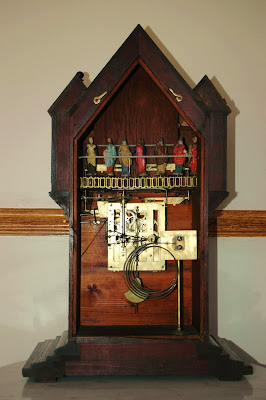
We want to share with you another clock that is a special part of our collection. This is a large Black Forest shelf clock with Automata. It was made by Gordian Hettich and Sohn in Furtwangen, Germany C. 1890.

The case on this piece is done in oak to replicate a Cathedral. In the center of the Cathedral is a large silvered dial that tells the time. Above the dial is two large turrets in the upper tower of the Cathedral.

On the hour the Church bells toll (on three deep gongs). As the bells toll... the two large doors on the upper turrets open. The twelve apostles proceed to walk out of the right turret door and cross the open balcony to the other side. When the last of the Twelve enters the door on the opposite tower the bells stop and the doors close. This is repeated on the hour every hour or on demand.

According to the GHS factory catalog which we have in our collection. The figures of the twelve apostles were reproduced from the famous masterwork works of sculpture Peter Vischer which can be seen in Nürnberg.
All 12 figures are holding items in their hands, from the holy scriptures to weapons to protect Jesus. The last of the twelve is holding a large sack of coins... there is no question to his identity!
The automation can also be activated on demand by a pull cord. There is also a shut off lever with an ivory knob pushing this knob in towards the case will deactivate the automation and gongs, for peace and quiet.
The movement in this clock is a large cast brass movement which is heald together with tapered pins. The movement is clearly stamped GHS on the the bottom center of the back plate. This is a unique and complex movement that was made for the apostle clock, meaning it was produced just for this piece, and not a normal production movement that was modified by the factory.
The automation is controlled by a set of large drive gears located above the plates of the movement. When these drive gears turn they rotate to large wood drums. A hand made brass "chain" runs around these drums, and the wood carved apostles are fixed to the top of the chain standing one infront of the other. When the barrels turn the apostles are looped through the front of the clock across the balcony and back to the inside of the case. There is also a series of cams that open and close the two doors on the front of the turrets at the correct time. A series of three hammers strike three separate high quality gongs, which are mounted to a rod fixed to the bottom of the case.
The time section of the movement will run for 8 days on a winding, the automation and strike must be wound every 36 hours.
We do not know how many of these Apostle Automaton clocks were produced by GHS, but we do know they are extremely rare today. This example with the Ortenburger pedigree... will always hold a special spot in our collection.
This identical clock was documented in the book, "Black Forest Clocks" by Rick Ortenburger in 1991. This book is the most complete and authoritative book on the subject published in English.
This clock was worthy to have a full page dedicated to it, showing both the front as well as the movement with a detailed description. This is an honor held by only a small handful of special clocks throughout the 265+ page text.
For us... this clock represents the end of a nearly 10 year search, to locate and purchase this piece. Years ago we set out to find, locate, and purchase several of the unique or Rare Black Forest clocks that were photographed in the Ortenburger text. Over the past decade we have located nearly all of the clocks on our list, and they are now a part of our private museum.
This clock is being shown here as we purchased it.
The bars seen in the photo above were added to keep the figures upright. When the automation is in action they move across the track,and they tend to wobble around and get hung up.
You can see in the photo taken from Ortenburgers text the bars have been there since at least 1991. Since they are not permidently attached to the clock, and aid in the automation working without problems... we have decided to leave them on the clock.
The clock is in working condition, and we have included a video to show you this piece in action.
The clock does need some minor restoration to the case, which we have plans to get underway in 2010.
We will update this post when the clock is finished.
Best,
Justin J. Miller


No comments:
Post a Comment